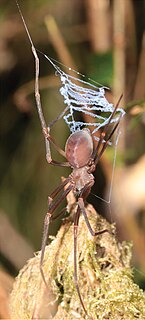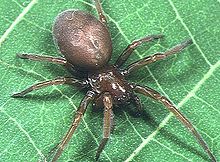
Uloboridae is a family of non-venomous spiders, known as cribellate orb weavers or hackled orb weavers. Their lack of venom glands is a secondarily evolved trait. Instead, they wrap their prey thoroughly in silk, cover it in regurgitated digestive enzymes, and then ingest the liquified body.

Crevice weaver spiders (Filistatidae) comprise cribellate spiders with features that have been regarded as "primitive" for araneomorph spiders. They are weavers of funnel or tube webs. The family contains 18 genera and more than 120 described species worldwide.

Velvet spiders are a small group of spiders almost entirely limited to the Old World, with exception of a few species known from Brazil. The characteristics of this family of spiders are that they are entelegyne, eight-eyed araneomorph spiders that build unkempt webs. They are cribellate. Some species are nearly eusocial, lacking only a specialized caste system and a queen. They cooperate in brood rearing, unlike most other spiders except for some African agelenid spiders in the genus Agelena and a few others.

Amaurobiidae is a family of three-clawed cribellate or ecribellate spiders found in crevices and hollows or under stones where they build retreats, and are often collected in pitfall traps. Unlidded burrows are sometimes quite obvious in crusty, loamy soil. They are difficult to distinguish from related spiders in other families, especially Agelenidae, Desidae and Amphinectidae. Their intra- and interfamilial relationships are contentious. According to the World Spider Catalog, 2019, the family Amaurobiidae includes about 275 species in 49 genera.

Zoropsidae, also known as false wolf spiders for their physical similarity to wolf spiders, is a family of cribellate araneomorph spiders first described by Philipp Bertkau in 1882. They can be distinguished from wolf spiders by their two rows of eyes that are more equal in size than those of Lycosidae.

Dictynidae is a family of cribellate, hackled band-producing spiders first described by Octavius Pickard-Cambridge in 1871. Most build irregular webs on or near the ground, creating a tangle of silken fibers among several branches or stems of one plant.

Cribellum literally means "little sieve", and in biology the term generally applies to anatomical structures in the form of tiny perforated plates.

Austrochilidae is a small spider family with ten species in three genera. Austrochilus and Thaida are endemic to the Andean forest of central and southern Chile and adjacent Argentina, while Hickmania is endemic to Tasmania. The monophyly of the family and the relationships among the genera are uncertain as of May 2017.

Phyxelididae is a family of araneomorph spiders first described by Pekka T. Lehtinen in 1967 as a subfamily of Amaurobiidae, and later elevated to family status as a sister group of Titanoecidae.

Nigma is a genus of cribellate araneomorph spiders in the family Dictynidae, and was first described by Pekka T. Lehtinen in 1967. They have a wide distribution, including Eurasia, North America, and Northern Africa. N. walckenaeri is one of the biggest members of the Dictynidae, growing up to 5 millimetres (0.20 in) long. They are translucent green and sometimes have red or black markings on the abdomen.
Saltonia is a monotypic genus of North American cribellate araneomorph spiders in the family Dictynidae containing the single species, Saltonia incerta. It was first described by R. V. Chamberlin & Wilton Ivie in 1942, and has only been found in United States. Originally placed with the funnel weavers, it was moved to the Dictynidae in 1967.
Mexitlia is a genus of North American cribellate araneomorph spiders in the family Dictynidae, and was first described by Pekka T. Lehtinen in 1967. As of May 2019 it contains only three species: M. altima, M. grandis, and M. trivittata.

Pandava is a genus of araneomorph spiders in the family Titanoecidae.
Devendra is a genus of Asian false wolf spiders first described by Pekka T. Lehtinen in 1967.
Agelenella is a genus of Asian funnel weavers containing the single species, Agelenella pusilla. It was first described by Pekka T. Lehtinen in 1967, and has only been found in Yemen.
Arangina is a genus of South Pacific cribellate araneomorph spiders in the family Dictynidae, and was first described by Pekka T. Lehtinen in 1967. As of May 2019 it contains only two species, both found in New Zealand: A. cornigera and A. pluva.
Iviella is a genus of North American cribellate araneomorph spiders in the family Dictynidae, and was first described by Pekka T. Lehtinen in 1967. As of May 2019 it contains only three species: I. newfoundlandensis, I. ohioensis, and I. reclusa.
Tahuantina is a monotypic genus of South American cribellate araneomorph spiders in the family Dictynidae containing the single species, Tahuantina zapfeae. It was first described by Pekka T. Lehtinen in 1967, and has only been found in Chile.

Brigittea is a genus of araneomorph spiders in the family Dictynidae, first described by Pekka T. Lehtinen in 1967.

Megadictynidae is a family of araneomorph spiders first described by Pekka T. Lehtinen in 1967. They are endemic to New Zealand.














